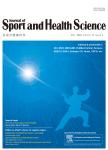How does high-intensity intermittent training affect recreational endurance runners? Acute and chronic adaptations: A systematic review
How does high-intensity intermittent training affect recreational endurance runners? Acute and chronic adaptations: A systematic review作者机构:Department of Corporal Expression University of Jaen Department of Sports Sciences University of Granada
出 版 物:《Journal of Sport and Health Science》 (运动与健康科学(英文))
年 卷 期:2017年第6卷第1期
页 面:54-67页
核心收录:
学科分类:0403[教育学-体育学] 040303[教育学-体育教育训练学] 04[教育学] 1002[医学-临床医学] 1010[医学-医学技术(可授医学、理学学位)]
基 金:the University of Jaén for its support to the present study
主 题:Endurance High-intensity training Intermittent exercises Interval running Long-distance runners Running
摘 要:Objective: This systematic review aimed to critically analyze the literature to determine how high-intensity intermittent training(HIIT) affects recreational endurance runners in the short-and long-term.Methods: Electronic databases were searched for literature dating from January 2000 to October 2015. The search was conducted using the key words high-intensity intermittent training or high-intensity interval exercise or interval running or sprint interval training and endurance runners or long distance runners. A systematic approach was used to evaluate the 783 articles identified for initial review. Studies were included if they investigated HIIT in recreational endurance runners. The methodological quality of the studies was evaluated using the Physiotherapy Evidence Database(PEDro) scale(for intervention studies) and the modified Downs and Black Quality Index(for cross-sectional studies).Results: Twenty-three studies met the inclusionary criteria for review. The results are presented in 2 parts: cross-sectional(n = 15) and intervention studies(n = 8). In the 15 cross-sectional studies selected, endurance runners performed at least 1 HIIT protocol, and the acute impact on physiological, neuromuscular, metabolic and/or biomechanical variables was assessed. Intervention studies lasted a minimum of 4 weeks, with 10 weeks being the longest intervention period, and included 2 to 4 HIIT sessions per week. Most of these studies combined HIIT sessions with continuous run(CR) sessions; 2 studies subjects performed HIIT exclusively.Conclusion: HIIT-based running plans(2 to 3 HIIT sessions per week, combining HIIT and CR runs) show athletic performance improvements in endurance runners by improving maximal oxygen uptake and running economy along with muscular and metabolic adaptations. To maximize the adaptations to training, both HIIT and CR must be part of training programs for endurance runners.



